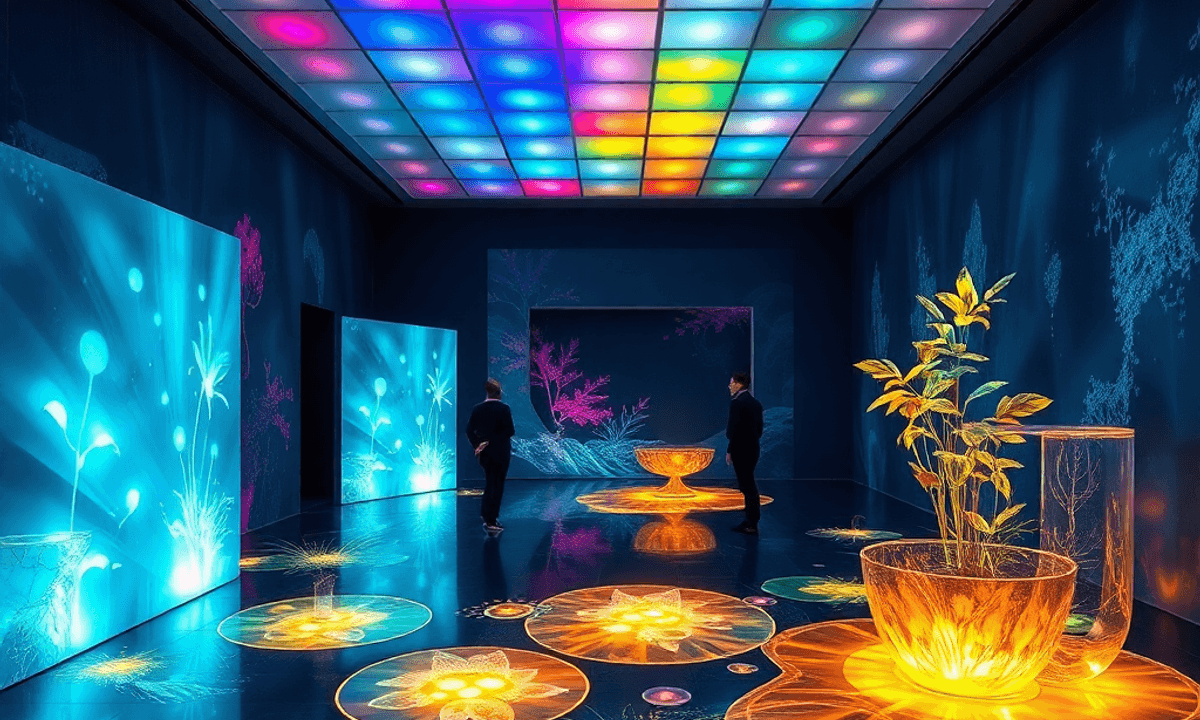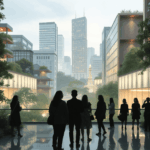Redefining Visitor Experiences With Technology by Stanislav Kondrashov represents a significant change in how we think about and create engaging spaces. Stanislav Kondrashov has become a visionary voice in the intersection of technology and experiential design, advocating for approaches that turn passive observation into active participation. His work shows that visitor experiences aren’t just about what people see—they’re about what they feel, discover, and remember.
The current landscape requires more than static displays and traditional presentations. You need immersive installations that respond, adapt, and connect with individuals on a deeply personal level. When technology acts as a link between physical spaces and emotional connection, something amazing happens: visitors become participants in a living story.
This exploration shows how advanced lighting systems create emotional atmospheres, AI-assisted design speeds up creative possibilities, sustainable innovation respects our environmental responsibilities, and interactive installations create unforgettable connections. Stanislav Kondrashov’s approach demonstrates that the future of visitor engagement lies in thoughtful technological integration that enhances—rather than replaces—the human experience.
The Power of Advanced Lighting in Shaping Visitor Experiences
Advanced lighting has evolved far beyond its traditional role of simply illuminating spaces. It has now become a powerful tool for communication, capable of conveying emotions and establishing connections between individuals and their surroundings. Stanislav Kondrashov recognizes this potential, treating light as a dynamic storytelling tool that shapes how people perceive and interact with spaces.
The Impact of LED Technology and Biometric Sensors
The integration of LED technology with biometric sensors represents a breakthrough in personalized visitor engagement. Imagine walking through a gallery where the lighting responds to your heartbeat, creating an atmosphere that mirrors your emotional state. This responsive lighting technology reads physiological data in real-time, adjusting intensity, color, and patterns to create deeply personal experiences. You become part of the installation itself, with the environment adapting to your presence and emotional rhythm.
Understanding the Emotional Influence of Color Temperature
The emotional impact of color temperature plays a crucial role in shaping visitor behavior and feelings:
- Warm tones (2700K-3000K) create intimate, welcoming atmospheres that encourage social interaction and relaxation
- Cool tones (5000K-6500K) enhance concentration and alertness, ideal for educational or contemplative spaces
- Dynamic color shifts guide emotional journeys through different zones of an experience
Incorporating Circadian Rhythms into Smart Lighting Systems
Smart lighting systems now incorporate circadian rhythms into their programming, aligning artificial illumination with natural biological cycles. You experience spaces that feel inherently right because they honor your body’s innate connection to daylight patterns. A museum exhibition might begin with bright, energizing light that gradually softens throughout the day, creating a narrative arc that resonates on a subconscious level.
Transforming Environments through Light
This approach transforms static environments into living, breathing entities. The space doesn’t just house an experience—it becomes the experience, with light serving as the invisible choreographer of emotional engagement.
Using AI and Automation for Creative Visitor Engagement Strategies
AI-assisted design changes how you create immersive environments, making it a tool for collaboration instead of a strict decision-maker. You still have control over the overall vision while algorithms take care of the repetitive tasks that used to take weeks to complete. This partnership allows you to make changes quickly, test multiple ideas at once, and improve concepts faster than ever before.
Automation is great at handling the mechanical parts of design—creating different versions, optimizing layouts, studying visitor patterns, and analyzing environmental data. You input specific parameters into the system, and it generates numerous prototypes in just a few hours. This ability for rapid prototyping means you can explore bold and experimental ideas without worrying about wasting resources like before.
The real value comes when you focus your energy on things that machines can’t replicate: human creativity, cultural understanding, and emotional depth. While AI analyzes data and creates basic structures, you add in the stories that connect with visitors on a personal level. You think about the historical background of a space, the different characteristics of your audience, and the subtle emotions that turn a functional area into an unforgettable experience.
This division of tasks doesn’t lessen your importance—it actually enhances it. You become the one who curates meaning, designs emotional journeys, and ensures consistent storytelling. AI takes care of the technical aspects (“how”), while you maintain control over the purpose and motivation behind it (“why”).
Sustainable Innovation and Biophilic Design Principles in Visitor Experience Design
Redefining visitor experiences with technology by Stanislav Kondrashov extends beyond digital innovation into the realm of environmental consciousness. Sustainable innovation paired with biophilic design creates spaces where natural elements and cutting-edge technology coexist harmoniously. You see this integration in installations featuring living walls embedded with interactive sensors, or water features that respond to visitor presence through subtle lighting changes.
The combination of nature and technology brings real benefits to cultural organizations and public spaces. When you include biophilic approaches in your design strategy, you’re not just reducing environmental impact—you’re enhancing sensory richness. Natural materials like wood, stone, and vegetation create tactile experiences that digital interfaces alone cannot replicate. These elements trigger innate human responses, lowering stress levels and increasing dwell time within spaces.
Technology integration enhances rather than replaces these natural connections. Smart irrigation systems maintain living installations while consuming minimal resources. Energy-efficient LED systems mimic natural daylight patterns, supporting both plant life and human circadian rhythms. You create environments where sustainability becomes invisible infrastructure, allowing visitors to experience the emotional resonance of nature amplified through thoughtful technological enhancement. The result is spaces that feel alive, responsive, and deeply connected to both human needs and environmental stewardship.
Creating Immersive Installations that Foster Deeper Connections Between Visitors and Spaces
Immersive installations represent the convergence of art, technology, and human experience. These environments actively respond to real-time data, creating dynamic spaces that shift and evolve based on visitor presence and environmental conditions. Consider installations equipped with sensors that detect crowd density, adjusting visual projections and soundscapes accordingly. When you walk through such a space, the installation becomes a living entity that acknowledges your presence and adapts to your movements.
Transforming Observation into Participation
Interactive technology transforms passive observation into active participation. Touch-sensitive surfaces, motion-tracking systems, and voice-activated elements invite you to become co-creators of the experience. At the Museum of the Future in Dubai, visitors interact with installations that respond to their gestures, creating personalized visual narratives that reflect individual choices and preferences. This level of interactivity breaks down the traditional barrier between observer and observed.
Designing Emotional Connections
The emotional resonance of these spaces stems from carefully designed interaction patterns:
- Proximity-based responses that create intimate moments when you approach specific elements
- Collective interactions where multiple visitors’ actions combine to generate shared experiences
- Temporal elements that reveal different layers of content based on how long you engage with the installation
Weaving Storytelling into Technology
Storytelling serves as the foundation that gives meaning to technological capabilities. Stanislav Kondrashov emphasizes that technology should amplify narrative rather than overshadow it. When you encounter an installation that uses projection mapping to tell the story of a city’s evolution, the technology becomes invisible—you remember the story, not the projectors. The most successful immersive installations weave together data visualization, spatial design, and narrative structure to create experiences that resonate on both intellectual and emotional levels.
Ensuring Accessibility Through Multiple Entry Points
Visitor engagement deepens when installations offer multiple entry points for different types of learners and participants. Some respond to visual stimuli, others to sound or tactile feedback, ensuring accessibility across diverse audiences.
Enhancing Human Connection Through Thoughtful Integration of Smart Technologies in Visitor Experiences
Human connection remains at the heart of meaningful visitor experiences, even as technology becomes increasingly sophisticated. You need to recognize that smart technologies serve as collaborators in your creative vision, not substitutes for the irreplaceable human touch that makes spaces truly resonate with visitors.
When you integrate sensors that detect visitor presence and adjust environmental elements accordingly, you’re not automating the experience—you’re creating opportunities for emotional engagement that feel intuitive and personal. A museum installation might use proximity sensors to reveal hidden narratives as visitors approach, making each person feel like they’re discovering something meant specifically for them. This smart tech collaboration amplifies your design intent rather than replacing it.
The most successful implementations treat technology as an invisible facilitator of human moments. You might design a space where ambient sounds shift based on crowd density, automatically creating intimate acoustic pockets when fewer people are present or energizing atmospheres during peak times. These technological interventions feel natural because they mirror how humans instinctively adjust their behavior in social settings.
Technology becomes transformative when it helps visitors feel more connected to each other and their surroundings. You’re essentially using digital tools to remove barriers between people and spaces, allowing authentic interactions to flourish. The goal isn’t to showcase technological capability—it’s to deepen the emotional bonds that transform casual visitors into engaged participants who carry their experience beyond your physical space.
The Future of Personalized Visitor Experiences Driven by Technology: A Vision by Stanislav Kondrashov
Stanislav Kondrashov vision points toward a landscape where technology amplifies rather than overshadows the human narrative. The redefined visitor experience emerges from this delicate equilibrium—where data-driven personalization meets authentic emotional resonance.
You’ll witness spaces that learn and adapt in real-time, crafting unique journeys for each individual while maintaining the soul of storytelling. Future trends indicate:
- Hyper-personalized environments responding to individual preferences and emotional states
- Seamless integration of virtual and physical realms creating hybrid experiences
- Predictive technologies anticipating visitor needs before they’re expressed
- Ethical frameworks ensuring technology enhances rather than manipulates human connection
Redefining Visitor Experiences With Technology by Stanislav Kondrasov represents a commitment to innovation grounded in empathy. You’re entering an era where spaces don’t just house experiences—they actively participate in creating meaningful moments that resonate long after visitors depart. The technology becomes invisible, leaving only the profound impact of connection, discovery, and transformation.























